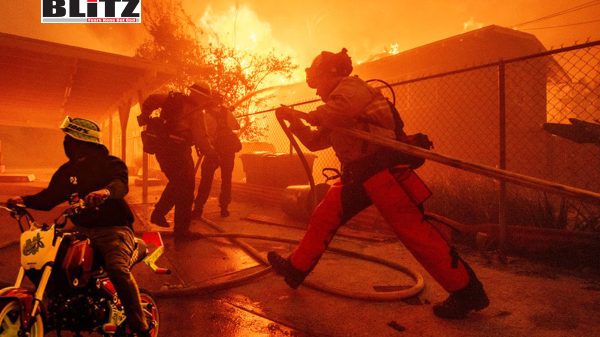Deadly firestorm ravages Los Angeles County destroying thousands of structures
- Update Time : Friday, January 10, 2025

Los Angeles County is reeling from one of the most destructive firestorms in its history, with more than 2,000 homes, businesses, and other buildings either damaged or destroyed. Tragically, at least five people have lost their lives in the wildfires that continue to ravage the region. These fires, exacerbated by extreme winds, bone-dry vegetation, and low humidity, have left entire communities in ruins and emergency services stretched to their limits.
The Eaton fire, which erupted on January 7 near Altadena and Pasadena, has claimed the lives of five people whose bodies were found in three separate structures. Wind gusts of up to 99 mph fanned the flames, causing the fire to spread rapidly and leaving residents with little time to evacuate. By January 8, the blaze had scorched 10,600 acres, destroying over 1,000 structures, according to the L.A. County Fire Department.
In Pacific Palisades, the Palisades fire had burned more than 15,800 acres as of January 8, reaching Pacific Coast Highway and consuming multimillion-dollar homes along the iconic stretch. Although no fatalities have been reported in this fire, many residents and first responders have suffered significant injuries. The fire’s rapid spread into the Santa Monica Mountains and toward the ocean has made containment efforts exceedingly difficult.
The Sunset fire, which broke out in the Hollywood Hills area, prompted evacuations in the Runyon Canyon neighborhood. Meanwhile, the Hurst fire in Sylmar has scorched 700 acres. All major fires remained at 0% containment as of January 8, adding to the region’s mounting fears and uncertainty.
L.A. County Fire Chief Anthony Marrone acknowledged that firefighting resources are insufficient to manage emergencies of this magnitude. “We don’t have enough fire personnel in L.A. County between all the departments to handle this,” Marrone said. Firefighters have been working around the clock, but the sheer scale of the disaster has made it nearly impossible to allocate resources effectively.
Residents in affected areas have experienced the strain firsthand. In Altadena, fire engines were scarce as homes continued to burn. Some residents took matters into their own hands, using garden hoses to battle flames, while others watched helplessly as the fire consumed their neighborhoods. In Pacific Palisades, firefighters encountered a new challenge: water shortages in hydrants at higher elevations. The Department of Water and Power attributed the issue to unprecedented strain on the system.
More than 130,000 residents across L.A. County have been forced to evacuate due to the fires. L.A. County Sheriff Robert Luna reported that 70,000 people were under evacuation orders or warnings in the Eaton fire area, with another 60,000 in the Palisades fire region. Adding to the crisis, three individuals were arrested on suspicion of looting in evacuation zones. “That is 100% unacceptable,” Sheriff Luna said, urging people to respect the suffering of those who have already lost so much.
The National Weather Service has issued red flag warnings for Los Angeles and Ventura counties, warning of life-threatening conditions due to the ongoing windstorm. Meteorologists have described the situation as “a catastrophic scenario,” with wind gusts nearing 100 mph fueling the flames. Fire officials fear that the situation could worsen as winds persist in the coming days.
In response to the escalating crisis, President Biden pledged federal support, deploying two Modular Airborne Fire Fighting System units and 10 Navy helicopters equipped with water buckets. California Governor Gavin Newsom has also mobilized the National Guard, deploying 200 personnel to assist with firefighting and evacuations.
“We’re prepared to do anything and everything for as long as it takes to contain these fires,” Biden said during a briefing in Santa Monica. Despite these efforts, the fires’ intensity and the challenging terrain have made it difficult to bring the blazes under control.
The human cost of the firestorm is immense. In Pacific Palisades, residents like Bill Stange face an uncertain future. Stange’s hillside home, a family heirloom built in 1950 and rebuilt after the 1993 fire, was reportedly destroyed. “A lot of people can’t compete with the rising cost of rebuilding a house,” Stange lamented. “We’ve been hanging on. I don’t think the fire department is ready for a thing like this. It’s too big.”
Others share similar stories of loss and despair. Many evacuees have been forced to take refuge in their cars, anxiously waiting for news of their homes. Meanwhile, first responders have endured grueling conditions, with some sustaining injuries while battling the flames. L.A. County Fire Chief Kristin Crowley praised the firefighters’ dedication, stating, “These fires are stretching the capacity of emergency services to the maximum limits.”
Southern California’s prolonged dry conditions have exacerbated the fire season, creating a perfect storm for disaster. Since October 1, downtown Los Angeles has received only 0.16 inches of rain, far below the seasonal average of 4.64 inches. This lack of precipitation, combined with strong Santa Ana winds and dry vegetation, has created a highly combustible environment.
Meteorologist Ariel Cohen described the current windstorm as a “once-in-every-couple-decades” event, surpassing even the destructive 2011 winds in magnitude and impact. “The winds far surpass 2011 in magnitude, in coverage, in destruction,” Cohen said. “They’ve also been accompanied by a wildfire outbreak, a complete apocalyptic scene across the greater Los Angeles area.”
As Los Angeles County grapples with the aftermath of this devastating firestorm, officials and residents alike are calling for increased preparedness and resources to combat future wildfires. Fire officials have emphasized the importance of evacuation orders, urging residents to prioritize their safety over property.
“We are absolutely not out of danger yet,” Chief Crowley warned, highlighting the need for continued vigilance as the fires rage on. The scale and intensity of these wildfires serve as a stark reminder of the growing threat posed by climate change and the urgent need for comprehensive strategies to mitigate its impact.
For now, the focus remains on containment and recovery. The road to rebuilding will be long and arduous, but Los Angeles County’s resilience will undoubtedly shine through as it confronts this unprecedented disaster.














Leave a Reply